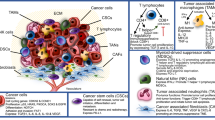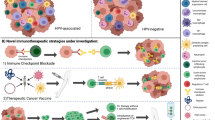Abstract
While studies have indicated that squamous cell carcinoma of the head and neck (HNSCC) is associated with immune suppression, these studies did not analyze the immune response at the dysplastic stage. The present study utilized a mouse model of 4-nitroquinoline 1-oxide-induced oral carcinogenesis to examine the alterations in immune phenotype at the premalignant and malignant stages of HNSCC. Cervical lymph nodes of HNSCC-bearing mice were found to contain a greater number of cells, including a greater number of conventional (Tconv) and regulatory (Treg) T cells, compared to cervical lymph nodes of control and premalignant lesion-bearing mice, though the Tconv cells appear to be less proliferative and the Treg cells appear to be less suppressive at the HNSCC stage. Premalignant lesion-bearing mouse lymph nodes consist of a greater percentage of Tconv cells expressing markers for activation, memory, and exhaustion compared to both control and HNSCC-bearing mice. Also, lymph nodes’ cells from both premalignant lesion-bearing and HNSCC-bearing mice include increased levels of Th1, Tc1, and Th17 cells, with no differences in levels of Th2 cells, compared to control mice. The data show that while there is the expected increase in immunosuppressive Tregs in lymph nodes when HNSCC is present, there is also an unexpected increase in immune populations usually associated with a beneficial antitumor response, including Tconv cells and Th1 and Tc1 cells. In addition, the results demonstrate that the premalignant stage of HNSCC development is associated with a robust immune response involving an increase in inflammatory Th1, Tc1, and Th17 cells.






Similar content being viewed by others
References
Forastiere A, Koch W, Trotti A, Sidransky D (2001) Head and neck cancer. N Engl J Med 345(26):1890–1900. doi:10.1056/NEJMra001375
Hauswald H, Simon C, Hecht S, Debus J, Lindel K (2011) Long-term outcome and patterns of failure in patients with advanced head and neck cancer. Radiat Oncol 6(1):70. doi:10.1186/1748-717X-6-70
King GN, Healy CM, Glover MT, Kwan JT, Williams DM, Leigh IM, Worthington HV, Thornhill MH (1995) Increased prevalence of dysplastic and malignant lip lesions in renal-transplant recipients. N Engl J Med 332(16):1052–1057. doi:10.1056/NEJM199504203321602
Harris JP, Penn I (1981) Immunosuppression and the development of malignancies of the upper airway and related structures. Laryngoscope 91(4):520–528
Bose A, Chakraborty T, Chakraborty K, Pal S, Baral R (2008) Dysregulation in immune functions is reflected in tumor cell cytotoxicity by peripheral blood mononuclear cells from head and neck squamous cell carcinoma patients. Cancer Immun 8:10
Bergmann C, Strauss L, Wang Y, Szczepanski MJ, Lang S, Johnson JT, Whiteside TL (2008) T regulatory type 1 cells in squamous cell carcinoma of the head and neck: mechanisms of suppression and expansion in advanced disease. Clin Cancer Res 14(12):3706–3715. doi:10.1158/1078-0432.CCR-07-5126
Badoual C, Hans S, Rodriguez J, Peyrard S, Klein C, Agueznay Nel H, Mosseri V, Laccourreye O, Bruneval P, Fridman WH, Brasnu DF, Tartour E (2006) Prognostic value of tumor-infiltrating CD4+ T-cell subpopulations in head and neck cancers. Clin Cancer Res 12(2):465–472. doi:10.1158/1078-0432.CCR-05-1886
Young MR, Wright MA, Lozano Y, Prechel MM, Benefield J, Leonetti JP, Collins SL, Petruzzelli GJ (1997) Increased recurrence and metastasis in patients whose primary head and neck squamous cell carcinomas secreted granulocyte-macrophage colony-stimulating factor and contained CD34+ natural suppressor cells. Int J Cancer 74(1):69–74
Lathers DM, Achille NJ, Young MR (2003) Incomplete Th2 skewing of cytokines in plasma of patients with squamous cell carcinoma of the head and neck. Hum Immunol 64(12):1160–1166
Williams R, Lee DW, Elzey BD, Anderson ME, Hostager BS, Lee JH (2009) Preclinical models of HPV+ and HPV− HNSCC in mice: an immune clearance of HPV+ HNSCC. Head Neck 31(7):911–918. doi:10.1002/hed.21040
Rajjoub S, Basha SR, Einhorn E, Cohen MC, Marvel DM, Sewell DA (2007) Prognostic significance of tumor-infiltrating lymphocytes in oropharyngeal cancer. Ear Nose Throat J 86(8):506–511
Zeng X, Chen Q, Nie M (2003) The relationship of Fas and Fas L protein expression in oral carcinogenesis. Hua Xi Kou Qiang Yi Xue Za Zhi 21(4):259–262
Igney FH, Krammer PH (2005) Tumor counterattack: fact or fiction? Cancer Immunol Immunother 54(11):1127–1136. doi:10.1007/s00262-005-0680-7
Schoop RA, Noteborn MH, Baatenburg de Jong RJ (2009) A mouse model for oral squamous cell carcinoma. J Mol Histol 40(3):177–181. doi:10.1007/s10735-009-9228-z
Strati K, Pitot HC, Lambert PF (2006) Identification of biomarkers that distinguish human papillomavirus (HPV)-positive versus HPV-negative head and neck cancers in a mouse model. Proc Natl Acad Sci USA 103(38):14152–14157. doi:10.1073/pnas.0606698103
O’Malley BW Jr, Cope KA, Johnson CS, Schwartz MR (1997) A new immunocompetent murine model for oral cancer. Arch Otolaryngol Head Neck Surg 123(1):20–24
Sudhoff HH, Schwarze HP, Winder D, Steinstraesser L, Gorner M, Stanley M, Goon PK (2011) Evidence for a causal association for HPV in head and neck cancers. Eur Arch Otorhinolaryngol 268(11):1541–1547. doi:10.1007/s00405-011-1714-8
Verastegui E, Morales R, Barrera JL, Mueller A, Guzman B, Meneses A, Alfaro G (2002) Immunological approach in the evaluation of regional lymph nodes of patients with squamous cell carcinoma of the head and neck. Clin Immunol 102(1):37–47. doi:10.1006/clim.2001.5130
Berinstein NL (2009) Strategies to enhance the therapeutic activity of cancer vaccines: using melanoma as a model. Ann NY Acad Sci 1174:107–117. doi:10.1111/j.1749-6632.2009.04935.x
Fourcade J, Sun Z, Benallaoua M, Guillaume P, Luescher IF, Sander C, Kirkwood JM, Kuchroo V, Zarour HM (2010) Upregulation of Tim-3 and PD-1 expression is associated with tumor antigen-specific CD8+ T cell dysfunction in melanoma patients. J Exp Med 207(10):2175–2186. doi:10.1084/jem.20100637
Dutton RW, Bradley LM, Swain SL (1998) T cell memory. Annu Rev Immunol 16:201–223. doi:10.1146/annurev.immunol.16.1.201
Pure E, Cuff CA (2001) A crucial role for CD44 in inflammation. Trends Mol Med 7(5):213–221
Rosshart S, Hofmann M, Schweier O, Pfaff AK, Yoshimoto K, Takeuchi T, Molnar E, Schamel WW, Pircher H (2008) Interaction of KLRG1 with E-cadherin: new functional and structural insights. Eur J Immunol 38(12):3354–3364. doi:10.1002/eji.200838690
Vesely MD, Kershaw MH, Schreiber RD, Smyth MJ (2011) Natural innate and adaptive immunity to cancer. Annu Rev Immunol 29:235–271. doi:10.1146/annurev-immunol-031210-101324
Wilke CM, Kryczek I, Wei S, Zhao E, Wu K, Wang G, Zou W (2011) Th17 cells in cancer: help or hindrance? Carcinogenesis 32(5):643–649. doi:10.1093/carcin/bgr019
Kesselring R, Thiel A, Pries R, Trenkle T, Wollenberg B (2010) Human Th17 cells can be induced through head and neck cancer and have a functional impact on HNSCC development. Br J Cancer 103(8):1245–1254. doi:10.1038/sj.bjc.6605891
Lopez-Cabrera M, Santis AG, Fernandez-Ruiz E, Blacher R, Esch F, Sanchez-Mateos P, Sanchez-Madrid F (1993) Molecular cloning, expression, and chromosomal localization of the human earliest lymphocyte activation antigen AIM/CD69, a new member of the C-type animal lectin superfamily of signal-transmitting receptors. J Exp Med 178(2):537–547
Poulton TA, Gallagher A, Potts RC, Beck JS (1988) Changes in activation markers and cell membrane receptors on human peripheral blood T lymphocytes during cell cycle progression after PHA stimulation. Immunology 64(3):419–425
Henson SM, Franzese O, Macaulay R, Libri V, Azevedo RI, Kiani-Alikhan S, Plunkett FJ, Masters JE, Jackson S, Griffiths SJ, Pircher HP, Soares MV, Akbar AN (2009) KLRG1 signaling induces defective Akt (ser473) phosphorylation and proliferative dysfunction of highly differentiated CD8+ T cells. Blood 113(26):6619–6628. doi:10.1182/blood-2009-01-199588
Ibegbu CC, Xu YX, Harris W, Maggio D, Miller JD, Kourtis AP (2005) Expression of killer cell lectin-like receptor G1 on antigen-specific human CD8+ T lymphocytes during active, latent, and resolved infection and its relation with CD57. J Immunol 174(10):6088–6094
Day CL, Kaufmann DE, Kiepiela P, Brown JA, Moodley ES, Reddy S, Mackey EW, Miller JD, Leslie AJ, DePierres C, Mncube Z, Duraiswamy J, Zhu B, Eichbaum Q, Altfeld M, Wherry EJ, Coovadia HM, Goulder PJ, Klenerman P, Ahmed R, Freeman GJ, Walker BD (2006) PD-1 expression on HIV-specific T cells is associated with T-cell exhaustion and disease progression. Nature 443(7109):350–354. doi:10.1038/nature05115
Boni C, Fisicaro P, Valdatta C, Amadei B, Di Vincenzo P, Giuberti T, Laccabue D, Zerbini A, Cavalli A, Missale G, Bertoletti A, Ferrari C (2007) Characterization of hepatitis B virus (HBV)-specific T-cell dysfunction in chronic HBV infection. J Virol 81(8):4215–4225. doi:10.1128/JVI.02844-06
Hanada T, Kobayashi T, Chinen T, Saeki K, Takaki H, Koga K, Minoda Y, Sanada T, Yoshioka T, Mimata H, Kato S, Yoshimura A (2006) IFNgamma-dependent, spontaneous development of colorectal carcinomas in SOCS1-deficient mice. J Exp Med 203(6):1391–1397. doi:10.1084/jem.20060436
Matsuda M, Nakamoto Y, Suzuki S, Kurata T, Kaneko S (2005) Interferon-gamma-mediated hepatocarcinogenesis in mice treated with diethylnitrosamine. Lab Invest 85(5):655–663. doi:10.1038/labinvest.3700257
Reiners JJ Jr, Rupp T, Colby A, Cantu AR, Pavone A (1989) Tumor copromoting activity of gamma-interferon in the murine skin multistage carcinogenesis model. Cancer Res 49(5):1202–1206
Xiao M, Wang C, Zhang J, Li Z, Zhao X, Qin Z (2009) IFNgamma promotes papilloma development by up-regulating Th17-associated inflammation. Cancer Res 69(5):2010–2017. doi:10.1158/0008-5472.CAN-08-3479
Bettelli E, Carrier Y, Gao W, Korn T, Strom TB, Oukka M, Weiner HL, Kuchroo VK (2006) Reciprocal developmental pathways for the generation of pathogenic effector TH17 and regulatory T cells. Nature 441(7090):235–238. doi:10.1038/nature04753
Acknowledgments
This work was supported by the Medical Research Service of the Department of Veterans Affairs and by grants RO1 CA128837 and RO1 DE018268 from the National Institutes of Health to MRIY.
Author information
Authors and Affiliations
Corresponding author
Rights and permissions
About this article
Cite this article
De Costa, AM.A., Schuyler, C.A., Walker, D.D. et al. Characterization of the evolution of immune phenotype during the development and progression of squamous cell carcinoma of the head and neck. Cancer Immunol Immunother 61, 927–939 (2012). https://doi.org/10.1007/s00262-011-1154-8
Received:
Accepted:
Published:
Issue Date:
DOI: https://doi.org/10.1007/s00262-011-1154-8




